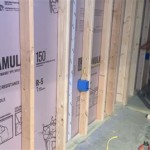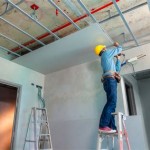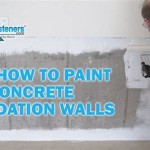Moisture Level in Basement Walls: Understanding and Addressing the Issue
Moisture in basement walls is a common problem facing homeowners, and understanding the sources, consequences, and potential solutions is crucial for maintaining a healthy and structurally sound home. Excess moisture can lead to a range of issues, including mold growth, structural damage, and decreased indoor air quality. Monitoring and managing moisture levels in basement walls is therefore a key aspect of home maintenance.
Several factors contribute to moisture accumulation in basement walls. These factors can be related to the surrounding environment, the construction of the basement itself, and the existing drainage systems. A thorough understanding of these contributing elements is the first step towards effective moisture management. Identifying the source of the moisture is essential for selecting the most appropriate and lasting solution.
Sources of Moisture in Basement Walls
Several sources can contribute to elevated moisture levels in basement walls. These sources can be categorized broadly as external and internal factors. External factors relate to conditions outside the home that influence the amount of moisture entering the basement, while internal factors arise from activities and conditions within the home itself.
Hydrostatic Pressure: This refers to the pressure exerted by groundwater against the basement walls and floor. The water table level surrounding the home significantly influences this pressure. High water tables, common in areas with heavy rainfall or poor drainage, can force water through the concrete and mortar of the basement walls. Cracks, even hairline fractures, in the foundation provide easy pathways for water infiltration under hydrostatic pressure. The type of soil surrounding the foundation also plays a role; clay soils, being less permeable, hold more water and increase the hydrostatic pressure.
Surface Water Runoff: Rainfall, snowmelt, and improper drainage around the home's foundation can lead to surface water runoff accumulating near the basement walls. If the ground slopes towards the house rather than away from it, water will naturally flow towards the foundation. Gutters and downspouts that are clogged, damaged, or improperly positioned can exacerbate this problem by directing water directly against the foundation walls. This concentrated water exposure increases the likelihood of moisture penetration.
Condensation: Warm, humid air inside the basement coming into contact with the cooler surfaces of the basement walls can lead to condensation. This is particularly problematic during the summer months when the temperature difference between the inside and outside is significant. Activities like showering, doing laundry, or cooking can increase humidity levels inside the basement, contributing to condensation on the walls. Inadequate ventilation further aggravates this issue, preventing the moist air from escaping.
Capillary Action: Porous materials like concrete and brick can draw moisture upwards from the ground through capillary action. This phenomenon occurs because the small pores in the material act like tiny straws, drawing water molecules upwards against gravity. While capillary action alone may not cause a severe flooding problem, it can contribute to a persistently damp environment in the basement walls, fostering mold growth and other related issues.
Plumbing Leaks: Leaks from pipes, drains, or appliances within the basement can introduce significant amounts of moisture into the walls. Even small, slow leaks can saturate the surrounding concrete or drywall over time, leading to mold growth and structural damage. It is crucial to regularly inspect plumbing fixtures and pipes for any signs of leaks and address them promptly.
Consequences of Elevated Moisture Levels
The consequences of unchecked moisture levels in basement walls extend beyond superficial dampness. They can compromise the structural integrity of the home, impact indoor air quality, and lead to health problems for the occupants.
Mold Growth: Mold thrives in damp, dark environments. Basement walls, particularly those with organic materials like drywall or wood paneling, provide an ideal breeding ground for mold when moisture is present. Mold growth can lead to musty odors, discoloration of surfaces, and, in severe cases, structural damage. More importantly, mold spores can circulate in the air and trigger allergic reactions, asthma attacks, and other respiratory problems, especially in sensitive individuals.
Structural Damage: Continuous exposure to moisture can weaken the concrete and mortar in basement walls. Water can penetrate cracks and freeze during cold weather, causing the cracks to widen and deepen through a process known as freeze-thaw cycling. Over time, this can compromise the structural integrity of the foundation, leading to settling, wall bowing, and even collapse in extreme cases. Wood framing and other organic materials in the basement are also susceptible to rot and decay when exposed to prolonged moisture.
Decreased Indoor Air Quality: Moisture in basement walls can contribute to poor indoor air quality in several ways. Mold growth releases spores and volatile organic compounds (VOCs) into the air, which can irritate the respiratory system and cause other health problems. Damp conditions can also promote the growth of dust mites, which are a common allergen. Furthermore, the excessive humidity in the basement can migrate to other parts of the house, making the entire home feel damp and uncomfortable.
Damage to Stored Items: Basements are often used for storage, but elevated moisture levels can damage stored items. Cardboard boxes, books, clothing, and furniture can absorb moisture, leading to mold growth, mildew, and rot. Metal objects can rust, and electronics can malfunction. The cost of replacing damaged items can be significant, and storing valuables in a damp basement is generally not recommended.
Pest Infestation: Damp basements provide an attractive habitat for various pests, including insects, rodents, and termites. These pests thrive in moist environments and can cause further damage to the structure of the house and contaminate stored items. Termites, in particular, can cause significant structural damage by feeding on wood framing. Controlling pest infestations requires addressing the underlying moisture problem.
Methods for Addressing Moisture Issues
Addressing moisture issues in basement walls requires a multi-faceted approach that targets the source of the moisture and implements preventative measures. A combination of strategies may be necessary to effectively manage moisture levels and prevent future problems.
Improving Drainage: Ensuring proper drainage around the foundation is crucial for preventing surface water runoff from accumulating near the basement walls. This includes grading the soil so that it slopes away from the house, cleaning gutters and downspouts regularly, and extending downspouts away from the foundation. Installing French drains, which are perforated pipes buried in gravel-filled trenches, can also help to redirect groundwater away from the foundation.
Waterproofing: Waterproofing the basement walls involves applying a sealant or membrane to the exterior or interior of the walls to prevent water penetration. Exterior waterproofing is generally more effective but also more expensive, as it requires excavating around the foundation. Interior waterproofing involves applying a sealant to the interior walls, which is typically less expensive but may not address the underlying source of the moisture. The choice between exterior and interior waterproofing depends on the severity of the moisture problem and the homeowner's budget.
Controlling Condensation: Reducing humidity levels in the basement can help to prevent condensation on the walls. This can be achieved by installing a dehumidifier, improving ventilation, and insulating cold water pipes. A dehumidifier removes excess moisture from the air, while improved ventilation allows moist air to escape. Insulating cold water pipes prevents them from cooling the surrounding air and causing condensation on their surfaces.
Repairing Cracks: Sealing cracks in the basement walls is essential for preventing water from entering through these pathways. Small cracks can be filled with epoxy or hydraulic cement, while larger cracks may require more extensive repairs, such as patching or crack injection. It is important to address cracks promptly to prevent them from worsening over time and compromising the structural integrity of the walls.
Maintaining Plumbing: Regularly inspecting plumbing fixtures and pipes for leaks and addressing them promptly is crucial for preventing water damage. Even small, slow leaks can saturate the surrounding concrete or drywall over time, leading to mold growth and structural damage. Replacing old or corroded pipes can also help to prevent future leaks.
Ventilation and Air Circulation: Adequate ventilation in the basement is essential for removing moist air and preventing condensation. This can be achieved by opening windows when weather permits, installing exhaust fans in areas with high humidity, such as bathrooms and laundry rooms, and using a dehumidifier to remove excess moisture from the air. Ensuring good air circulation within the basement can also help to prevent stagnant air and promote even drying of the walls.

Moisture In Basements Causes And Solutions Umn Extension

5 Signs Your Basement Has Excess Moisture Zephyr Thomas

Moisture In Basements Causes And Solutions Umn Extension

How To Lower Your Basement S Humidity Level

Overview Dehumidification In The Basement Or Crawl Space

How To Lower Your Basement S Humidity Level

What S Causing Moisture In Basements How To Fix It Waterproofing Pd

Managing Indoor Humidity And Ventilation In Cold Weather Building America Solution Center

Managing Humidity Summer Basement Problems And Fixes Tar Heel Systems

Fighting Basement Humidity In The Summer Maryland







